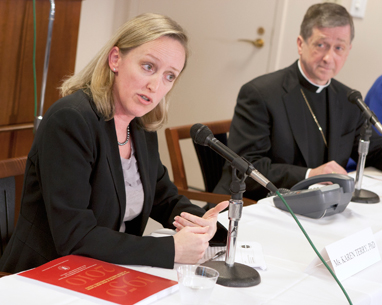America’s Catholic bishops commissioned John Jay College of Criminal Justice to study the sex-abuse crisis in the American Church. Last November, the bishops received a briefing on some conclusions researchers have derived from their report, “The Nature and Scope of the Problem of Sexual Abuse of Minors by Catholic Priests and Deacons in the United States.”
They say the crisis has nothing to do with homosexuality.
Margaret Smith, a data analyst, said researchers believe “the idea of sexual identity [should] be separated from the problem of sexual abuse.” She insists that no connection has been found “between homosexual identity and an increased likelihood of sexual abuse.” This was seconded by the study’s principal investigator, Karen Terry: “Someone can commit sexual acts that might be of a homosexual nature, but not have a homosexual identity.”
Some greeted these statements with skepticism; not least because the data Smith, Terry, et al. have gathered indicate that more than 80 percent of all clerical abuse cases involve male homosexual activity. Dr. Terry’s point is that abuse may be more about opportunity than preference. Since during the period covered by the inquiry (1950 to 2002), priests had more frequent interaction with boys than with girls, the overwhelmingly male-male nature of the abuse doesn’t prove the abusers themselves were homosexual.
Ms. Smith emphasized this point by analogizing the behavior of the abusing priests with the sexual practices of men in prison.
But here are some data not in the report: The Centers for Disease Control puts the homosexual population in America at very precisely 2.3 percent (and no credible study claims a number higher than 3 percent). To be sure, opportunity plays a role in many crimes, but given that 90-plus percent of American men are heterosexual it seems out of proportion that 80-plus percent of clerical abuse cases (more than 4000 are included in the John Jay study) should involve men and boys. This is especially so since, according to the Department of Health and Human Services, girls are more than four times likelier to be the victims of sexual abuse than are boys in the population at large.
Whether these cases were pedophilia or hebephilia (those who prefer pubescent kids) or ephebophilia (attraction to older adolescents) is not at issue here, although it’s surely significant that half of those abused by priests were between the ages of 11 and 14. All the cases analyzed involved kids under 18, and none of the data or analysis addresses the violence done to the faith and psyches of the victims, to the vows of celibacy taken by the priests, or to the Body of Christ as a whole. That wasn’t the researchers’ job.

But there is also no acknowledgment of another key datum of all sex-abuse crimes: 60 percent of assaults go unreported. Boys are especially reluctant to speak up. One study (by the Commonwealth Fund) found that among “sexually abused children in grades five through twelve, 48 percent of the boys and 29 percent of the girls . . . told no one about the abuse.” So the data we have may hardly begin to describe the breadth and depth of the problem. More than $2 billion has been paid to victims and their attorneys.
Consider this: According to one scholarly journal, Archives of Sexual Behavior, the tendency towards homosexuality among pedophiles is fifteen- to twenty-times higher than in the population at large. The Journal of Sex Research has noted that the proportion of homosexual pedophiliac offenses “is substantially larger than the proportion of sex [offenses] against female children among heterosexual men . . .” And in a superb essay in Homiletic & Pastoral Review, Brian W. Clowes and David L. Sonnier make the important connection that in “the general population of males who sexually abuse minors, only one in seven molest boys. In the population of [sex-abusing] priests . . . six in seven molest boys.”
Most homosexual men aren’t pedophiles, of course, yet it seems likely that when in any population there’s a disproportionate spike in sexual-abuse statistics affecting boys, homosexuality belongs on the list of causes. Are the John Jay researchers unaware that 80 percent of sex abuse suffered by boys in public schools is at the hands of homosexual teachers, coaches, and administrators? Or do they also consider public schools analogous to prisons?
The data gathered by John Jay do not address the prevalence of homosexuality in the priesthood overall, but if homosexual men really do “hit on” kids more often than straight men seduce girls, don’t the data imply that a fairly significant cadre of non-abusing homosexuals is (or was) in the priesthood?
Why did these men take Holy Orders? Perhaps because emerging cultural tolerance of (and tentative self-acceptance by) homosexuals in the Forties and Fifties led to an expectation of fraternal refuge in the priesthood that was later made moot by “gay” advocacy in the Sixties and Seventies. Why hide in a hostile profession when you can now be “out” in most others? This could explain the bell curve in abuse statistics, which peaked in about 1980 and, thank God, have rapidly declined ever since. Perhaps the private crisis was ending even as it was becoming a public scandal.
The Catholic priesthood will no longer be a refuge for homosexuals. The Congregation for Catholic Education has published its “Instruction Concerning the Criteria for the Discernment of Vocations with regard to Persons with Homosexual Tendencies in view of their Admission to the Seminary and to Holy Orders,” another long-titled document with a different conclusion than John Jay’s:
[It is] necessary to state clearly that the Church, while profoundly respecting the persons in question, cannot admit to the seminary or to holy orders those who practice homosexuality, present deep-seated homosexual tendencies, or support the so-called “gay culture.”














